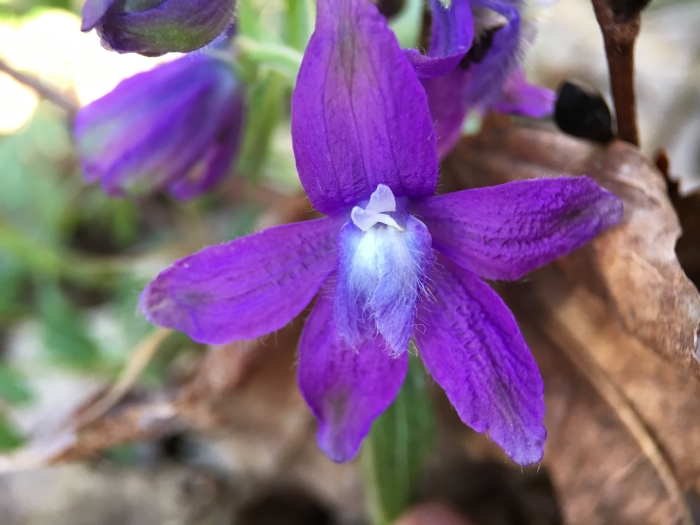Dwarf Larkspur
(Delphinium tricorne)
Dwarf Larkspur (Delphinium tricorne)
/
/

Matt Berger
CC BY 4.0
Image By:
Matt Berger
Recorded By:
Copyright:
CC BY 4.0
Copyright Notice:
Photo by: Matt Berger | License Type: CC BY 4.0 | License URL: http://creativecommons.org/licenses/by/4.0/ | Rights Holder: Matt Berger | Publisher: iNaturalist | Date Created: 2017-03-29T17:42:12-07:00 |






















































Estimated Native Range
Summary
Delphinium tricorne, commonly known as Dwarf Larkspur, is a deciduous perennial herb native to rich woodlands and forest clearings of the Central and Eastern United States. It typically grows to a height of 1-2 feet (0.3-0.6 meters) and a width of 0.8-2 feet (0.2-0.6 meters). Dwarf Larkspur is characterized by its upright form and showy spikes of blue, purple, and white flowers that bloom in the spring, adding a splash of color to the garden. The plant’s foliage is deeply lobed and provides a delicate texture.
Dwarf Larkspur is valued for its early-season blooms and is often used in woodland gardens, borders, and native plant gardens. It is a low-maintenance plant that prefers partial shade to full sun and thrives in rich, well-drained soils with consistent moisture. While it is not drought-tolerant, it can adapt to various soil types if proper care is taken. Dwarf Larkspur can be susceptible to crown rot if grown in poorly drained soils, and slugs and snails may damage the foliage. It is also important to note that all parts of the plant are toxic if ingested, so caution should be exercised in gardens accessible to pets and children. Despite its toxicity, it is a valuable plant for pollinators, attracting bees and butterflies.CC BY-SA 4.0
Dwarf Larkspur is valued for its early-season blooms and is often used in woodland gardens, borders, and native plant gardens. It is a low-maintenance plant that prefers partial shade to full sun and thrives in rich, well-drained soils with consistent moisture. While it is not drought-tolerant, it can adapt to various soil types if proper care is taken. Dwarf Larkspur can be susceptible to crown rot if grown in poorly drained soils, and slugs and snails may damage the foliage. It is also important to note that all parts of the plant are toxic if ingested, so caution should be exercised in gardens accessible to pets and children. Despite its toxicity, it is a valuable plant for pollinators, attracting bees and butterflies.CC BY-SA 4.0
Plant Description
- Plant Type: Herb
- Height: 1-2 feet
- Width: 0.8-1.5 feet
- Growth Rate: Moderate
- Flower Color: Blue, Purple, White
- Flowering Season: Spring
- Leaf Retention: Deciduous
Growth Requirements
- Sun: Full Sun, Part Shade
- Water: Medium
- Drainage: Medium
Common Uses
Bank Stabilization, Bee Garden, Bird Garden, Border Plant, Butterfly Garden, Deer Resistant, Hummingbird Garden, Rabbit Resistant, Showy Flowers
Natural Habitat
Rich woodlands and forest clearings
Other Names
Common Names: Vårriddarsporre, Rock Larkspur
Scientific Names: , Delphinium tricorne, Delphinium aconitifolium, Delphinium tricorne f. albiflora, Delphidium flexuosum, Delphinastrum tricorne, Delphinium flexuosum, Delphinium tricorne f. roseum, Delphinium tricorne f. tricorne, Delphinium tricorne var. genuinum
GBIF Accepted Name: Delphinium tricorne Michx.